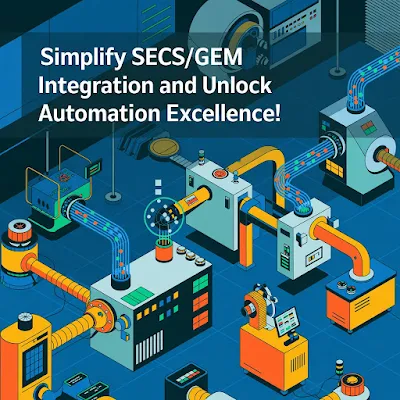In today’s rapidly evolving manufacturing environment, the need for seamless communication between equipment and factory systems has never been more critical. The SECS/GEM protocol—an established standard for semiconductor equipment communication—plays a pivotal role in enabling automation and improving operational efficiency. However, implementing SECS/GEM in modern factories is not without its challenges. This article explores these hurdles and offers insights into overcoming them, ensuring successful SECS/GEM integration.
Understanding SECS/GEM and Its Role in Modern Manufacturing
The SECS/GEM communication protocol, standardized by SEMI, provides a framework for interaction between factory systems and equipment. This protocol is particularly prevalent in semiconductor and electronics manufacturing but has applications across other industries as well.
By leveraging SECS/GEM software and the SECS/GEM interface, manufacturers can achieve real-time data exchange, enabling functions such as process control, equipment monitoring, and recipe management. The SECS/GEM Communication Protocol is fundamental to achieving the level of automation required in GEM300-compliant factories.
Common Challenges in SECS/GEM Implementation
While SECS/GEM offers numerous benefits, its implementation comes with unique challenges that can hinder seamless adoption. Some of the most common hurdles include:
1. Integration with Legacy Equipment
Many factories operate with a mix of new and legacy equipment. Ensuring that older machinery can communicate using the SECS/GEM protocol often requires additional adapters or modifications. Legacy systems may lack native SECS/GEM interfaces, necessitating the development of custom solutions for SECS/GEM integration.
2. Complexity in Configuration
The SECS/GEM software setup and configuration process can be intricate. Each piece of equipment requires careful mapping of variables and events to ensure compliance with the SECS/GEM Communication Protocol. Missteps during this phase can lead to communication failures or incomplete data exchanges.
3. Scalability Concerns
As factories expand their operations, they must scale their SECS/GEM infrastructure to accommodate new equipment and processes. Without proper planning, scaling up SECS/GEM communication can lead to bottlenecks or compatibility issues.
4. Lack of Expertise
Implementing and maintaining SECS/GEM systems requires specialized knowledge. Many factories face challenges in finding personnel skilled in SECS/GEM protocols, which can lead to delays and increased costs.
Strategies for Overcoming SECS/GEM Implementation Challenges
To address these challenges effectively, manufacturers must adopt a strategic approach that combines technical expertise, robust planning, and the right tools.
1. Invest in SECS/GEM Training
Developing in-house expertise is crucial for successful SECS/GEM implementation. Training programs that focus on the SECS/GEM protocol, SECS/GEM software, and the specifics of SECS/GEM communication can empower teams to manage and troubleshoot systems effectively.
2. Utilize Middleware for Legacy Equipment
Middleware solutions can bridge the gap between legacy equipment and modern factory systems. These tools enable older machines to communicate using the SECS/GEM communication protocol, ensuring compatibility without extensive hardware modifications.
3. Leverage Professional Services
Partnering with vendors or consultants who specialize in SECS/GEM integration can streamline the implementation process. These professionals bring valuable expertise in configuring SECS/GEM interfaces, ensuring compliance with the SECS/GEM protocol, and addressing specific factory needs.
4. Adopt Scalable Solutions
Scalability should be a priority when selecting SECS/GEM software and infrastructure. Modular solutions that can grow alongside factory operations will reduce the complexity and cost of future expansions.
5. Conduct Comprehensive Testing
Thorough testing is essential to validate SECS/GEM communication. Simulating real-world scenarios and stress-testing the SECS/GEM interface can identify potential issues before they impact production.
The Role of GEM300 in Enhancing SECS/GEM Capabilities
For factories striving to implement GEM300 standards, the SECS/GEM protocol serves as a backbone for automation. GEM300-compliant factories rely on SECS/GEM communication to achieve advanced capabilities such as lot scheduling, equipment state management, and process tracking. By integrating SECS/GEM software with GEM300 systems, manufacturers can unlock higher levels of efficiency and accuracy.
The SECS/GEM protocol is an indispensable tool for achieving automation and operational excellence in modern factories. While its implementation poses challenges, these can be overcome with the right strategies, tools, and expertise. By investing in training, leveraging middleware, and adopting scalable solutions, manufacturers can ensure seamless SECS/GEM communication and integration. For those aiming to meet GEM300 standards, mastering SECS/GEM software and interfaces is not just an option—it’s a necessity for staying competitive in today’s dynamic manufacturing landscape.
With careful planning and execution, the benefits of SECS/GEM integration—from improved productivity to enhanced process control—are well within reach.

No comments:
Post a Comment